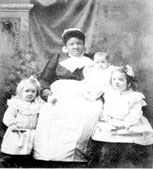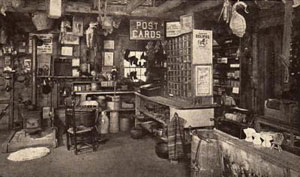|
H.C.
HAMELIN WAS SWEEPING the steps of his Hartney store one September
morning in 1896 when two passing strangers asked him if his store were
for sale.
“It is, if I can get the right price for it,” Hamelin answered.
He was facing some business difficulties and offered the stock to the
strangers at ninety cents on the dollar.
“Will you hold that offer open for three days?” one of the strangers
asked.
Hamelin agreed, hurried down the street to Harry Perrin’s office and
returned with a three-day option on the stock of the store, which was
signed by the three men. The two strangers drove away. They were A.E.
Hill, who owed a general store at Griswold, and his brother W.H.B.
(Harry) Hill.
The Hills took possession in October and named their new business “The
Red Star Store,” which name they dropped in 1898 and operated simply as
“The A.E. Hill Co., Ltd.” Harry was the manager from the time it was
purchased until his death in 1940, when his youngest daughter Irene
succeeded him. Through all his years in business Harry Hill was active
in community affairs. He represented the Hartney ward on the council of
Cameron Municipality, before the town was incorporated. After
incorporation he was a councillor for the new town and mayor in
1907-10. He was mayor continuously from 1917 until 1927. When Mr. Hill
retired as mayor in 1927
an address read by Mr. M. Render on behalf of the council and the town
reviewed the progress during his term of office, and an armchair was
presented him as a token of gratitude for his services.
W.H.B. Hill was active in the establishment of the “The Willard House”
as a temperance hotel and was the first president of the “The Hartney
Hotel Company.” He was a member of the Hartney Lyceum Theatre Company
that brought the first motion pictures to the town hall in 1910 and
that built the present theatre. He was an active member of the Masonic
Order and a staunch Anglican who, for 35 years, was the rector’s warden
of the Anglican church.
When Harry Hill died in 1940 his daughter, Irene, gave up her position
in the library of the University of Toronto and took over the
management of the Hartney store, with A.E. Hill to assist and advise
her. Mr Hill and his sister, Miss Louisa, had a few years previously
moved into a suite of rooms above the store where Miss Hill died in
1937. A.E. continued to occupy the rooms for many years more and lived
until 1953.
In July, 1956, the A.E. Hill Company Ltd., with members of their
present staff, held a reception to celebrate their 60th year in
business in Hartney. Misses Flora and Irene Hill and Mrs. Pelleran La
Gloire of Quebec, represented the company.
Adapted from The Mere
Living, page 147.
Irene
Hill
Irene Hill was sent to Ovenden College in Ontario and then to the
University of Toronto where she received a Bachelor of Arts degree. Her
application to the University’s Library was accepted and she spent 12
satisfying years there in different departments and in her spare time
typing manuscripts for one of Canada’s most renowned scholars. She was
secretary-treasurer of the Hartney Figure Skating Club, president of
the Hartney Golf Club, secretary of the Hartney-Cameron Chamber of
Commerce and librarian of the Hartney-Cameron Library for 30 years.
Adapted from A Century of Living, page 384.

The Hill children, including baby Irene, were cared
for by a nurse from mother Irene’s New Orleans home.

“Hills Corner,” as it came to be called, with the
A.E. Hill store on the right and the adjacent Lewis Block. The old
Avondale Hotel is on the left.
A
Day in the Life of a General Store
The small-town general store, also known as mercantiles and emporiums,
were essential aspect of commercial activity in small-town life, and
saw their heyday in the period between 1880 and 1930.
These establishments served the rural populations of small towns and
villages and the farmers in the surrounding area. Besides selling dry
goods, farming equipment and other supplies, they sometimes also served
as the local post office, drugstore and undertaker. They were also a
popular meeting place for socializing and news gathering.
The storekeepers stocked their establishments with merchandise procured
from salesmen who represented wholesale houses and manufacturers found
in larger cities. Merchandise selections were often large and varied,
though most of the items available for sale were those of necessity. As
people and businesses prospered in the economy during the 1890s more
luxury items were introduced into the store inventories. The expansion
of the railroads, the advent of mass production and technological
advances such as the refrigerated railcar to transport perishable foods
all combined to escalate the national distribution and variety of goods
that were available in the stores.
Most of the wall space in a general store was taken up with shelving to
store and display for the merchandise; likewise the floors were crowded
with barrels, wooden boxes and crates. Store counters were good for
holding display cases for the smaller items, a coffee grinder, scales
and a cash register. Many stores had a display window or two in the
front of the building. Cellars, basements and second floors were used
for storage of merchandise and displays.
The proprietors of general stores knew almost all of their customers
and they were adept at anticipating their needs. It was not uncommon
for articles to be sold on credit or for payment to be accepted in the
form of bartered goods.
What were some of the items that could be found in a general store?
Food and consumables included coffee beans, spices, baking powder,
oatmeal, flour, sugar, tropical fruit, hard candy, eggs, milk, butter,
fruit and vegetables, honey and molasses, crackers, cheese, syrup and
dried beans, cigars and tobacco.
Dry goods included bolts of cloth, pins and needles, thread, ribbon,
silk, buttons, collars, undergarments, suspenders, dungarees, hats and
shoes.
Essential items such as rifles, pistols, ammunition, lanterns, lamps,
rope, crockery, pots and pans, cooking utensils and dishes, farm and
milking equipment and even coffins could be found.
The apothecary sections of the stores were well represented with a
surprisingly large number of patent medicines, remedies, soaps and
toiletries and elixirs.

Many old general stores were dark and, depending
upon the geographical
location, probably damp and humid. Cast iron stoves heated the stores
during the cold months. Many of the stores may have been muddy and
dusty, given the foot traffic from unpaved roads.
|





